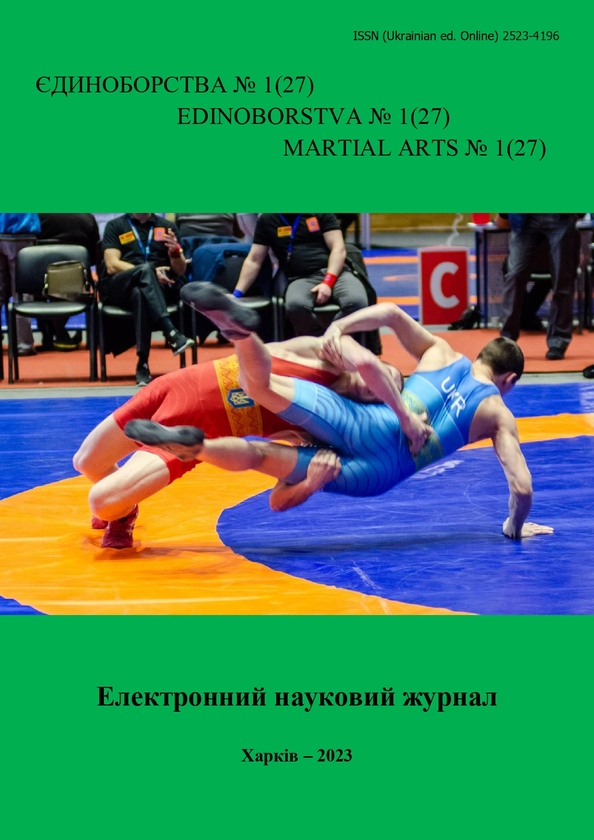Рівень фізичної підготовленості дзюдоїстів 19-21 років різних вагових категорій
DOI:
https://doi.org/10.15391/ed.2023-1.09Ключові слова:
дзюдо, спортсмени, змагальна діяльність, показники, висококваліфіковані, легкі вагові категоріїАнотація
Мета: виявити рівень фізичної підготовленості дзюдоїстів 19-21 років різних вагових категорій та здійснити їх порівняльну характеристику. Матеріал та методи. Застосовувалися наступні методи дослідження: аналіз і узагальнення науково-методичної літератури; педагогічне тестування; методи математичної статистики. Педагогічне тестування пройшли 30 дзюдоїстів, яких було поділено за групами по 10 спортсменів у відповідності до вагової категорії: легкі, середні, важкі. Результати: аналіз отриманих даних показав, що дзюдоїсти легких вагових категорій мають гарні показники в тестах: «5-ти кратне виконання вправи» – 8,9 секунд та «Кидки партнера через стегно за 10 с» – 9,2 разів, тим самим показуючи найкращій прояв координаційних здібностей та швидкісних якостей серед усіх груп вагових категорій. Представники середніх вагових категорій мають кращі показники в тестах: «Піднімання манекену захватом тулубу ззаду стоячи на паралельних скам’ях» – 20 разів та «Кидки манекену протягом 3-х хвилин» – коефіцієнт витривалості 0,8. Тим самим демонструючи перевагу у прояву силової витривалості та витривалості. Представники важких вагових категорій у порівнянні з дзюдоїстами інших вагових категорій мають гірші показники у всіх тестах, окрім тесту на гнучкість «Положення «борцівський міст», показавши найкращій результат – 58 см. Порівняльний аналіз всіх вагових категорій показує, що у дзюдоїстів легких та середніх вагових категорій спостерігається достовірна перевага над дзюдоїстами важких категорій, окрім показників на гнучкість, де перевагу мають представники важких вагових (легкі вагові категорії – t=4,79; р<0,05; середні вагові категорії – t=2,26; р<0,05). У швидкісно-силових показниках та на прояв швидкості легкі і середні вагові категорії не мають достовірних розрізнень. Висновки. Таким чином, дзюдоїсти легких вагових категорій відрізняються гарним проявом координаційних здібностей та швидкісних здібностей, спортсмени середніх вагових категорій мають перевагу у прояві силової витривалості та витривалості, представники важких вагових категорій мають гарні показники в прояву гнучкості та непогані показники швидкісних здібностей, але прояв координаційних здібностей та витривалості у них на слабкому рівні. Порівняльний аналіз фізичної підготовленості легких вагових категорій з середніми виявив достовірні розходження на перевагу легких у тестах, що характеризують прояв силової витривалості, координаційних здібностей, гнучкості. Порівняльний аналіз фізичних показників середніх вагових категорій з важкими показує на перевагу середніх вагових категорій над спортсменами важких у прояву силової витривалості, витривалості та швидкісно-силових здібностей. Порівняльний аналіз фізичних показників спортсменів легких вагових категорій з важкими виявив також статистично достовірні розходження. Найбільше розходження спостерігається у тестах координаційні здібності в перевагу легких вагових та на гнучкість в перевагу важких вагових.
Посилання
Бекас, О., & Паламарчук, Ю. (2009). Процес удосконалення фізичної підготовленості борців-дзюдоїстів протягом річного макроциклу на етапі спеціалізованої базової підготовки. Physical education, sport and health culture in modern society, (2 (6)), 88-91.
Бойко, В.Ф., & Данько, Г.В. (2004). Физическая подготовка борцов. Олимпийская литература, Київ.
Бойченко, Н.В., & Голубничій, Р.В. (2016). Особливості фізичної підготовки спортсменок, що займаються дзюдо. Єдиноборства, 11-13.
Бойченко, Н.В., & Сушко, Ю.П. (2011). Пути повышения скоростно-силовой подготовленности борцов высокой квалификации. Слобожанський науково-спортивний вісник, 2, 47-50.
Вовченко, І.І., & Рудницький, М.Л. (2014). Фізична підготовка дзюдоїстів. Студентська спортивна наука-2014, 132-134.
Добринський, В., Мудрик, Ж., & Щербинська, О. (2016). Розвиток швидкісно-силових якостей юних дзюдоїстів методом колового тренування. Молодіжний науковий вісник Східноєвропейського національного університету імені Лесі Українки, (24), 126-129.
Ермаков, С.С., Тропин, Ю.Н., & Бойченко, Н.В. (2016). Специальная физическая подготовка квалифицированных борцов. Єдиноборства, 20-22.
Загура, Ф. (2011). Комплексна оцінка фізичної підготовленості дзюдоїстів. Молода спортивна наука України, 95-99.
Коваленко, І.М. (2015). Організація тренувального процесу дзюдоїстів в групах підвищення спортивної майстерності. Вісник Чернігівського національного педагогічного університету. Серія: Педагогічні науки. Фізичне виховання та спорт, (129 (4)), 88-91.
Кривенцова, І.О., Огарь, Г.О., & Паніна, О.О. (2020). Силова підготовка в навчально-тренувальному процесі юних дзюдоїстів. Єдиноборства, 13-21.
Курілова, В.І., & Борсук, М.П. (2017). Оцінка рівня розвитку фізичних якостей кваліфікованих дзюдоїстів. Вісник Чернігівського національного педагогічного університету. Серія: Педагогічні науки, (143), 185-188.
Марандян, К.Н., & Бойченко, Н.В. (2019). Вдосконалення швидкісно-силових здібностей дзюдоїстів 15-16 років. Проблеми і перспективи розвитку спортивних ігор і єдиноборств у вищих навчальних закладах, 1, 48-51.
Паламарчук, Ю.Г., & Бекас, О.О. (2010). Дослідження взаємозв’язків показників загальної і спеціальної фізичної підготовленості дзюдоїстів 10–12 років. Вісник Запорізького національного університету, (2), 4, 23-32.
Подригало, Л.В., Галашко, А.И., & Лозовой, А.Д. (2007). Сравнительная оценка антропометрического развития спортсменов силовых видов спорта. Педагогика, психология и медико-биологические проблемы физического воспитания и спорта, 3, 107-111.
Стрикаленко, Є.А., Шалар, О.Г., Гузар, В.М., & Андрєєва, Р.І. (2022). Оптимізація фізичної підготовки кваліфікованих борців вільного стилю. Єдиноборства, 53-69.
Стрикаленко, Є., Шалар, О., & Гузар, В. (2022). Ефективність фізичної підготовки кваліфікованих борців. Проблеми і перспективи розвитку спортивних ігор і єдиноборств у вищих навчальних закладах, 1, 34-39.
Тропин, Ю.Н., & Бойченко, Н.В. (2017). Содержание различных сторон подготовки борцов. Єдиноборства, 79-83.
Тропин, Ю., & Бойченко, Н. (2018). Взаимосвязь психофизиологических показателей и физической подготовленности у квалифицированных борцов. Слобожанський науково-спортивний вісник, (2 (64)), 82-87.
Тропін, Ю. М., Панов, П. П., & Бєлобаба, С. Б. (2017). Фізична підготовка борців. Єдиноборства, 82-84.
Чумак, Ю. (2014). Стан фізичної підготовленості дзюдоїстів 14–16 років за показниками координаційних здібностей. Слобожанський науково-спортивний вісник, (4), 69-73.
Bekas, O., Palamarchuk, J., Korolchuk, A., & Lomynoga, S. (2019). Моделювання фізичної підготовленості дзюдоїстів 10–12 років на основі соматотипування. Physical education, sport and health culture in modern society, (2 (46)), 87-98.
Podrigalo, L.V., Volodchenko, A.A., Rovnaya, O.A., Podavalenko, O.V., & Grynova, T.I. (2018). The prediction of success in kickboxing based on the analysis of morphofunctional, physiological, biomechanical and psychophysiological indicators. Physical education of students, 22(1), 51-56.
Podrigalo, L., Rovnaya, O., Cynarski, W. J., Volodchenko, O., Volodchenko, J., & Halashko, O. (2019). Studying of physical development features of elite athletes of combat sports by means of special indexes. Ido Movement for Culture, 19(1), 51-57.













